Second. The fact of the horse being unconscious of the amount of his strength, can be proven to the satisfaction of any one. For instance, such remarks as these are common, and perhaps familiar to your recollection. One person says to another, “If that wild horse there was conscious of the amount of his strength, his owner could have no business with him in that vehicle; such light reins and harness, too; if he knew he could snap them asunder in a minute and be as free as the air we breathe;” and, “that horse yonder that is pawing and fretting to follow the company that is fast leaving him, if he knew his strength he would not remain long fastened to that hitching post so much against his will, by a strap that would no more resist his powerful weight and strength, than a cotton thread would bind a strong man.” Yet these facts made common by every day occurrence, are not thought of as anything wonderful. Like the ignorant man who looks at the different phases of the moon, you look at these things as he looks at her different changes, without troubling your mind with the question, “Why are these things so?” What would be the condition of the world if all our minds lay dormant? If men did not think, reason and act, our undisturbed, slumbering intellects would not excel the imbecility of the brute; we would live in chaos, hardly aware of our existence. And yet with all our activity of mind, we daily pass by unobserved that which would be wonderful if philosophised and reasoned upon, and with the same inconsistency wonder at that which a little consideration, reason and philosophy would be but a simple affair.
Thirdly. He will allow any object, however frightful in appearance, to come around, over or on him, that does not inflict pain.
We know from a natural course of reasoning, that there has never been an effected without a cause, and we infer from this, that there can be no action, either in animate or inanimate matter, without there first being some cause to produce it. And from this self-evident fact we know that there is some cause for every impulse or movement of either mind or matter, and that this law governs every action or movement of the animal kingdom. Then, according to this theory, there must be some cause before fear can exist; and, if fear exists from the effect of imagination, and not from the infliction of real pain, it can be removed by complying with those laws of nature by which the horse examines an object, and determines upon its innocence or harm.
A log or stump by the road-side may be, in the imagination of the horse, some great beast about to pounce upon him; but after you take him up to it and let him stand by it a little while, and touch it with his nose, and go through his process of examination, he will not care any thing more about it. And the same principle and process will have the same effect with any other object, however frightful in appearance, in which there is no harm. Take a boy that has been frightened by a false-face or any other object that he could not comprehend at once; but let him take that face or object in his hands and examine it, and he will not care anything more about it. This is a demonstration of the same principle.




